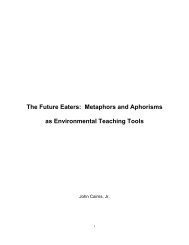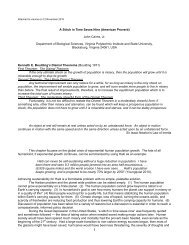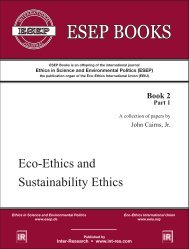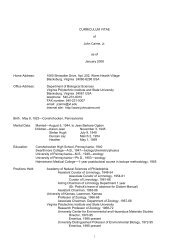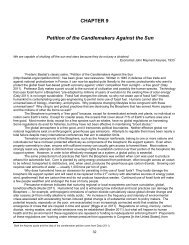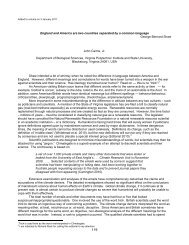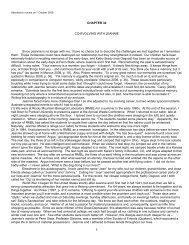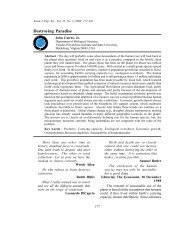View - ResearchGate
View - ResearchGate
View - ResearchGate
You also want an ePaper? Increase the reach of your titles
YUMPU automatically turns print PDFs into web optimized ePapers that Google loves.
Article 36303(of proof) onto proponents of potentially harmful activities, (3) exploring a wide range of alternativesto possibly harmful activities, and (4) increasing public participation in decision-making.Some publications offer general guidance for reducing uncertainty and provide illustrations ofattributes of both healthy and unhealthy ecosystems (e.g. National Research Council 2000) andtrends that are likely to have both beneficial and adverse effects upon the environment (NationalAcademy of Engineering 1997). The measurements of ecological footprint size for both individualsand societies (e.g. Wackernagel & Rees 1996) provide a means of reducing human impact on Earth.Anderson (1998) provides examples of moving toward a sustainable enterprise that shouldmarkedly reduce the human impact on evolutionary processes. The National Academy of Engineering(1996) provides insights on the reduction of engineering impacts upon ecosystems.Hawken et al. (1999) provide practical evidence that corporations that reduce environmentalimpact can still generate satisfactory profits. Clearly, much can be done now to reduce humanimpact on evolutionary processes by ensuring the maintenance of healthy ecosystems and restoringdamaged ecosystems (e.g. National Research Council 1992).EVOLUTIONARY ALTERATION OF HUMAN PROCESSESAncient Greeks believed the Earth was a living goddess named Gaia (Lovelock 1972, 1979). TheGaia hypothesis supposes Earth to be alive (Lovelock 1988) and assumes that the atmosphere, theoceans, the climate, and the crust of Earth are regulated at a state comfortable for life because ofthe behavior of living organisms. Homo sapiens happens to be one beneficiary of the processesthat produce the conditions favorable to Earth’s present species. However, drastic alteration of thebiosphere may result in a different set of conditions that still may be favorable to life, but not necessarilyto H. sapiens. Thus, the Gaia hypothesis proposes that the biosphere is a highly integratedand self-organized or controlled system. However, individual organisms and complex ecologicalsystems have important differences. Odum (1997) notes that the organism has set-point controlsthat maintain steady states at limits (homeostasis), while ecosystems have no set-point controls. Inthe ecosystem, positive and negative feedback maintains pulsing states at limits (homeorhesis).The absence of set-point controls persuades many scientists that ecosystems and the biospheredo not function as cybernetic systems, although most acknowledge that organisms play majorroles in the control of the chemistry of the atmosphere and the oceans (e.g. Kerr 1988). In short, asOdum (1997) remarks, although the biosphere has exhibited the resilience and stability to recoverin past ages, this history is no reason to be complacent about the resilience of present life-supportsystems. Clearly, human abuse of natural systems will have consequences that will affect thebenign conditions humans take for granted.EARTH RIGHTS AND HUMAN RIGHTSHow ironic that some nation-states, that proclaim the necessity for human rights, have thelargest ecological footprint and, therefore, the greatest impact on the living Earth. Continuedunsustainable practices that damage Earth’s ecological life support system will markedly affecthuman society and even human survival. Compassion for Earth is inextricably linked to compassionfor posterity (i.e. sustainable use of the planet) for which humankind has an ethical responsibility.Both the journals and books of the Eco-Ethics International Union provide information on theobligation of the present generation to future generations. In addition, Agyeman et al. (2003) alsodiscuss sustainable practices and posterity.



